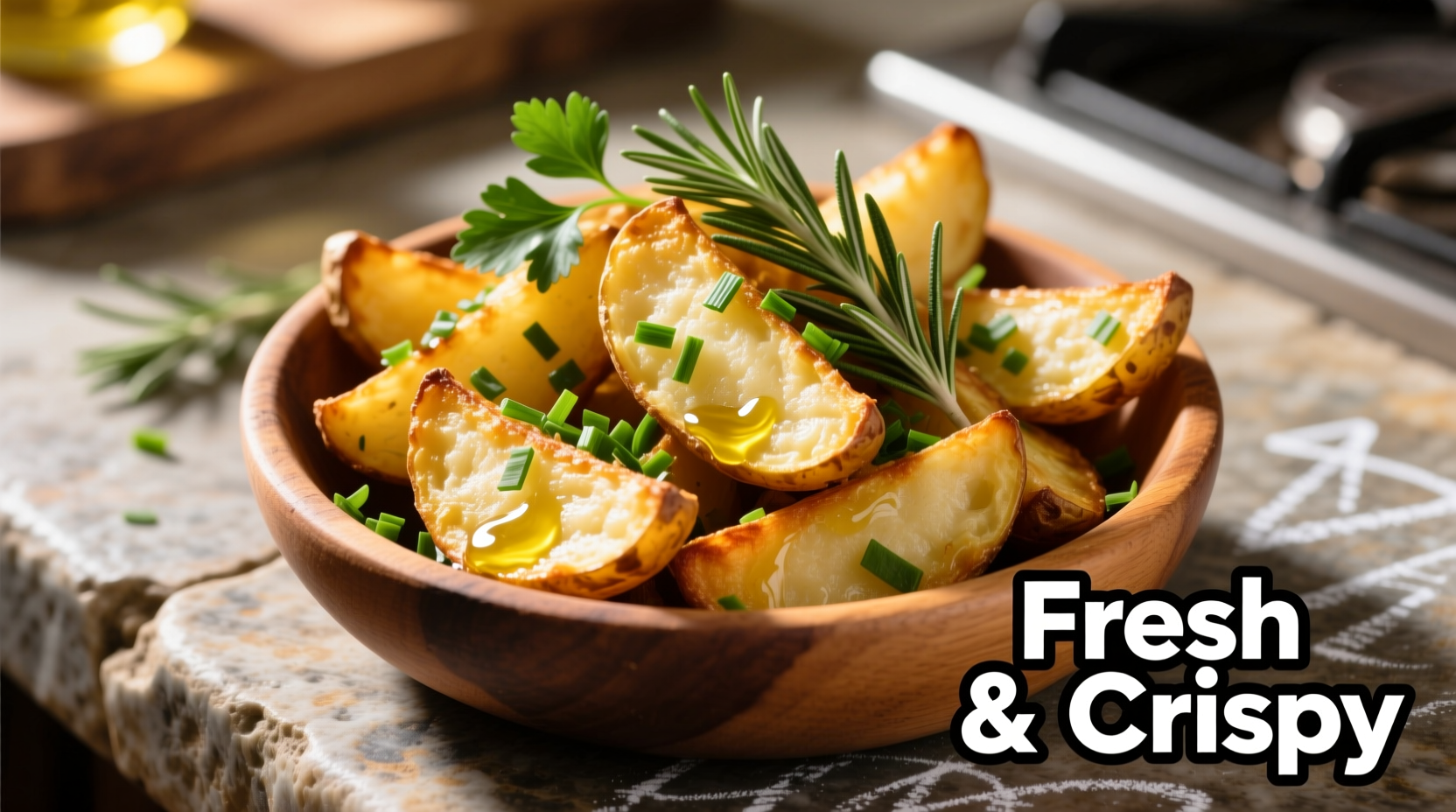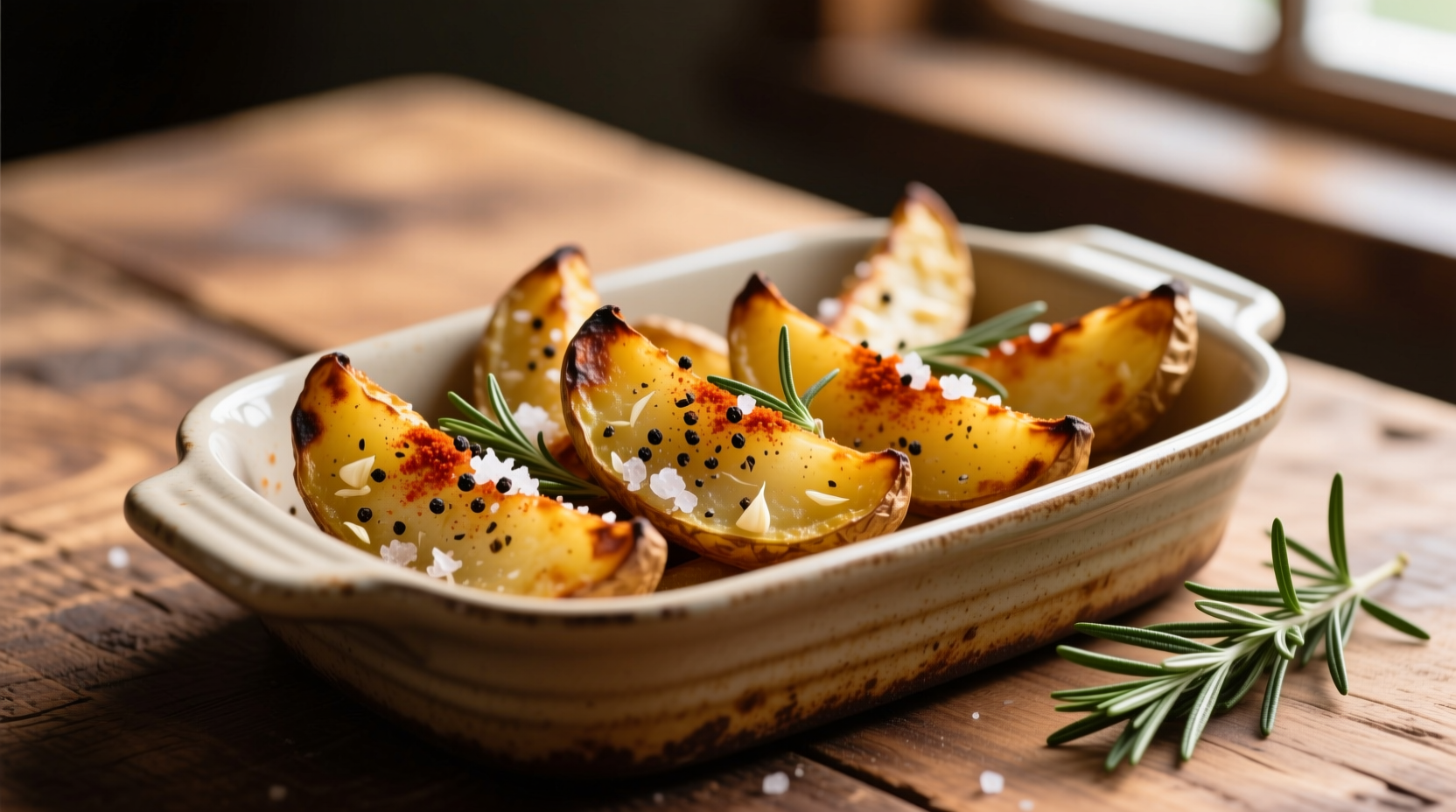The Science Behind Perfect Baked Potato Wedges
Many home cooks struggle with soggy, unevenly cooked potato wedges when baking. The secret lies in understanding potato chemistry. Potatoes contain starch that, when exposed to moisture during baking, creates steam that prevents crispiness. By removing excess surface starch through soaking and using the right baking technique, you transform ordinary potatoes into restaurant-quality wedges.
| Potato Variety | Starch Content | Best For Wedges? | Texture Result |
|---|---|---|---|
| Russet | High | ✓ Best choice | Crispy outside, fluffy inside |
| Sweet Potato | Medium | ✓ Good option | Slightly softer exterior |
| Yukon Gold | Medium-High | △ Acceptable | Less crispy, more tender |
| Red Potato | Low | ✗ Not recommended | Soggy exterior, waxy texture |
According to the USDA Food Safety and Inspection Service, proper potato preparation reduces acrylamide formation, a compound that can develop when starchy foods are cooked at high temperatures. Soaking potatoes before baking removes surface sugars that contribute to excessive browning.
Step-by-Step Perfect Potato Wedge Method
Preparation Phase: Setting Up for Success
Start with 2 pounds of Russet potatoes—University of Minnesota Extension confirms Russets' high starch content creates the ideal texture for baked wedges. Wash thoroughly and cut into uniform ¾-inch wedges. Consistent sizing ensures even cooking—varying sizes lead to some wedges burning while others remain undercooked.
Soak the cut wedges in cold water for 30 minutes. This critical step removes excess surface starch that would otherwise create steam during baking, preventing crispiness. For enhanced results, add 1 tablespoon of vinegar to the soaking water—the slight acidity helps maintain structure during cooking.

Baking Phase: Temperature and Technique
Preheat your oven to 425°F (220°C) with a baking sheet inside—this professional technique from culinary science ensures immediate crisping. While the oven heats, drain and thoroughly dry the potato wedges. Moisture is the enemy of crispiness, so pat them completely dry with clean kitchen towels.
Toss the wedges with 1½ tablespoons of high-smoke point oil (avocado or refined olive oil work best) and 1 teaspoon of fine sea salt. The oil-to-potato ratio is crucial—too little and they won't crisp, too much and they'll steam. Add seasonings after oiling to ensure even distribution.
Arrange wedges on the preheated baking sheet with space between each piece. Crowding causes steaming rather than baking. For optimal results, line the baking sheet with parchment paper to prevent sticking without adding extra oil.
Cooking Process: Timing and Turning
Bake for 25 minutes, then carefully flip each wedge using tongs. Rotate the baking sheet front-to-back for even heat distribution. Return to oven for another 15-20 minutes until deeply golden and crispy. The internal temperature should reach 205-210°F (96-99°C) for perfect tenderness.
Professional chefs at the Culinary Institute of America note that the final 5 minutes of baking make the difference between good and exceptional wedges. Resist opening the oven during the first 20 minutes—temperature fluctuations disrupt the crisping process.
Seasoning Strategies for Flavorful Wedges
Seasoning timing affects flavor penetration. For maximum impact:
- Before baking: Salt and garlic powder (oil helps these adhere)
- After baking: Fresh herbs, lemon zest, or delicate spices like smoked paprika
Antonio's Pro Tip: "Create a dry rub with 1 teaspoon each of garlic powder, onion powder, and smoked paprika mixed with 2 teaspoons of cornstarch. The cornstarch absorbs moisture and creates an extra-crispy coating while the spices infuse flavor."
Troubleshooting Common Problems
Why Are My Potato Wedges Soggy?
Sogginess typically results from:
- Insufficient drying after soaking
- Overcrowded baking sheet
- Incorrect oven temperature (use an oven thermometer to verify)
- Using low-starch potato varieties
How to Rescue Undercooked Wedges
If your wedges are soft but not crispy:
- Return to oven for 5-10 minutes
- Broil for 2-3 minutes (watch carefully)
- Place on a wire rack to allow air circulation underneath
When Baking Beats Frying: Context Matters
Baked potato wedges shine in specific scenarios where health considerations or equipment limitations make frying impractical:
- Health-conscious meals: Baked wedges use 70% less fat than deep-fried versions
- Large gatherings: Oven baking accommodates larger quantities simultaneously
- Kitchen limitations: No need for specialized equipment like deep fryers
- Safety concerns: Eliminates risks associated with hot oil handling
However, for authentic pub-style wedges with ultra-crispy exteriors, a combination method works best: par-cook in 300°F oil for 3 minutes, then finish in a 425°F oven. This technique, documented in Modernist Cuisine at Home, leverages the benefits of both methods.
Perfect Pairings: Dipping Sauces That Elevate Your Wedges
Create balanced flavor experiences with these professional pairings:
- Classic sour cream dip: Mix ½ cup sour cream with 2 tbsp chopped chives, 1 minced garlic clove, and lemon zest
- Spicy chipotle mayo: Combine ¾ cup mayonnaise with 1 tbsp adobo sauce and 1 tsp lime juice
- Herb yogurt dip: Blend 1 cup Greek yogurt with fresh dill, parsley, and mint
For optimal dipping experience, serve sauces at room temperature—cold sauces dull the perception of flavors in warm foods, according to sensory research from the Journal of Food Quality and Preference.
Storage and Reheating Guidelines
Store cooled wedges in an airtight container in the refrigerator for up to 3 days. For best results when reheating:
- Air fryer: 375°F for 5-7 minutes
- Oven: 400°F on a wire rack for 8-10 minutes
- Avoid microwave: Creates uneven texture and sogginess
Freeze unseasoned, par-cooked wedges for up to 3 months. When ready to use, bake frozen at 425°F for 30-35 minutes—no thawing required.
FAQ
Can I bake potato wedges without oil?
Yes, but results will be less crispy. For oil-free wedges, increase baking temperature to 450°F and toss potatoes with 1 tablespoon cornstarch before seasoning. The cornstarch creates a dry coating that promotes browning. Expect slightly drier texture than oil-based methods.
Why do my potato wedges stick to the baking sheet?
Sticking occurs when potatoes release moisture that caramelizes on the pan surface. Prevent this by preheating your baking sheet, using parchment paper, ensuring potatoes are thoroughly dried before oiling, and avoiding flipping too early (wait until they release naturally from the pan).
How do I prevent potato wedges from burning on the edges?
Cut uniform wedges, arrange with space between pieces, rotate the baking sheet halfway through cooking, and check for doneness starting at 20 minutes. If edges begin browning too quickly, reduce oven temperature by 25°F and move the sheet to a lower rack position.
What's the best way to season potato wedges for maximum flavor?
Apply salt and oil-soluble seasonings (garlic powder, onion powder) before baking. Add fresh herbs, citrus zest, and delicate spices after baking. For deeper flavor penetration, soak cut potatoes in seasoned water (1 quart water with 2 tbsp salt and desired seasonings) for 30 minutes before the standard water soak.











 浙公网安备
33010002000092号
浙公网安备
33010002000092号 浙B2-20120091-4
浙B2-20120091-4